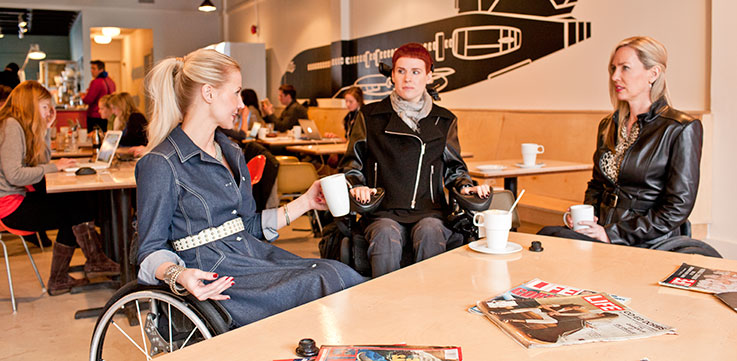 The word “fashion” often conjures up images of runways and of models with perfect bodies. Izzy Camillieri, owner and designer of IZ Adaptive, left that world to turn her talents to making clothing for people with disabilities. In doing so, she has reimagined the field of clothing design, putting function first while also celebrating form. Her innovative designs, which combine traditional patterns with the needs of her clients, are being honored in a six-month exhibit at the Textile Galleries of the Royal Ontario Museum.
The word “fashion” often conjures up images of runways and of models with perfect bodies. Izzy Camillieri, owner and designer of IZ Adaptive, left that world to turn her talents to making clothing for people with disabilities. In doing so, she has reimagined the field of clothing design, putting function first while also celebrating form. Her innovative designs, which combine traditional patterns with the needs of her clients, are being honored in a six-month exhibit at the Textile Galleries of the Royal Ontario Museum.
IZ Adaptive has progressed considerably since SMG first featured the company in December 2011. Izzy relates that, since that time, her website and Toronto store “have continuously added new items to the line, expanding new offerings for both men and women.” Improvements have come through being attentive and persistently trying new things. “The learning is continuous,” says Izzy, “listening to the needs of my clients.” She listens to their pocketbooks as well. “We see our line as mid-range in price.”
It’s no surprise that Izzy’s business has grown in the past few years, providing as it does a unique line of clothing to be best enjoyed from a wheelchair. “Knowing how underserved this market has been,” Izzy relates, “inspires us to make the best choices for our customers and business.” She is always on the qui vive for new materials and designs, seeking better ways to meet client needs. Says Izzy, “Our commitment continuously deepens each and every day.”
Dr. Alexandra Palmer, the Nora E. Vaughan Fashion Costume Senior Curator in the ROM’s World Cultures department, serves as curator for IZ Adaptive’s ROM exhibit. Palmer notes that she was motivated to collaborate on the fashion showcase because “Izzy’s perspective on clothing is radically different.
“Everyone looks at fashion, the creation of clothing, in a vertical way,” Palmer explains. “How the clothing will look on a standing person. Izzy thinks about how it will look and feel when the wearer is sitting or lying down.”
A Natural Fit
Palmer first learned of Izzy’s work by browsing her Toronto boutique. “I walked into her store in the Junction section of Toronto just to see the new shop,” Palmer relates. Palmer says she was particularly struck by the similarity in what was done historically with patterns to what Izzy is doing now. A fashion historian, Palmer not only specializes in trousers but also teaches a class on their history. She soon realized that Izzy’s fashiona designs and the Textile Galleries of the ROM would be a natural fit.

Palmer characterizes Izzy’s work as “very important,” even “transformative.” Why? Her emphasis is on creating designs that make customers feel good about themselves, not just prioritizing ease of medical access or emphasizing caregiver assistance for dressing.
“She tries to solve physical function issues with the clothes while producing fashionable items,” Palmer notes, “and the result is her line of very clever clothes. They look nice. But while they may not seem not extraordinary, they are extraordinary.”
The IZ Adaptive line has not gone unnoticed by the fashion community, either. “Izzy has been called ‘Canada’s most PC (Perfectly Cut) fashion designer’ for good reason,” Palmer relates. “She has broken new ground by designing and creating pieces for maximum comfort, ease, and style for those who have traditionally had difficulty finding clothing that is affordable and that fits.”
While accessibility advancements have been made for people with disabilities in many areas, the need for adaptive clothing had been largely overlooked until Izzy’s line made its debut. Since off-the-rack clothing is worn sitting down or standing up, designers before Izzy didn’t consider the impact of sitting as a person’s only position in the way clothes hang on the body.
For example, Palmer notes the case of a young man who uses a wheelchair but who has to travel quite a bit for business. Before purchasing trousers from IZ Adaptive, he had to worry about his trousers bunching up or falling down whenever he transferred to an airplane seat. Now, he reports, can travel in comfort, without worrying about his trousers falling to his ankles.
With a designer’s steady eye for fashion and trends, Izzy incorporates the latest colors, quality fabrics, and durable materials as she shapes her designs. “We are constantly listening, learning and inspired by the needs and desires of our clients,” she says. “Details of easier closures and ease of dressing are always top of my mind.”
Her website is full of testimonials from people with disabilities who have found her products comfortable, practical, and fun to wear. SMG’s own CEO Carmen Jones is a particular fan of the IZ adaptive coats. Izzy comments, “Our pants and coats are our most frequently purchased items.” Although children’s styles are unavailable as of yet, Izzy notes that “as soon as they are teenagers, they can fit into our smaller adult sizes.”
Striking a Pose
The shop in Toronto, the IZ Adaptive website, and the museum exhibit all display Izzy’s designs on fiberglass “Mannequals” that show how the clothing looks from a seated position. An innovation in the world of fashion, the “Mannequal” was the focus of an national advertising campaign in England four years ago. It was designed by artist, activist, and model Sophie Morgan. A paraplegic after a 2003 car accident, Morgan has continued with a career, often bringing disability issues to the foreground in her role as BBC television presenter. You can learn more about the “Mannequal” at www.mannequal.co.uk or on Sophie Morgan’s own site at www.sophiemorgan.com.
Once customers see designs at IZ Adaptive that they like, they can follow detailed directions on how to measure for and order the items. Izzy notes that, while she does have a physical location in Toronto, “our location is not really a store but a showroom where we serve our clients. All of our samples are there for clients to order from. We have not needed the space to expand.”

Izzy credits an enhanced web presence, new images of actual clients modeling the collection, videos about the history of the line, and videos highlighting the features of the clothing all with contributing to an increase in sales. Social media, bloggers, mailing lists, and mainstream marketing efforts help as well. She notes that IZ adaptive has been actively working with organizations to help spread the word about the clothing line.
She is also implementing good old-fashioned low shipping fees. “We have just introduced free shipping for orders over $100 in North America,” Izzy reports, “and a $30 flat fee for orders over $150 for international orders.” While most of IZ Adaptive’s sales come from the United States, customers in Canada and Australia make up a sizable portion of her shoppers as well.
Future of the Line
The ROM exhibit, called Fashion Follows Form, runs until the end of 2014 and spotlights the unique and innovative features of the collection. As a point of comparison, 18th and 19th century clothing designed for sitting will be featured as well. Izzy says, “The exhibit will also feature some of my past high-end fashion design work, to show and demonstrate my background and roots.”
Palmer adds, “We hope this exhibition inspires visitors to think about the role fashion plays in our daily lives as well as the historical relationship between fashion and function.”
Izzy says, “We want wheelchair users, their families, and caregivers to know that our line of clothing is a better alternative to mainstream, standing-frame cut clothing. These clothes are easier to put on, save time while dressing, and make dressing easier for both wearer and dresser. Our line allows for all-day comfort, without style being sacrificed. I often explain that the line is secondary to what it delivers in terms of dignity, sense of self, inclusion, and peace of mind.”
Leave a Reply
You must be logged in to post a comment.